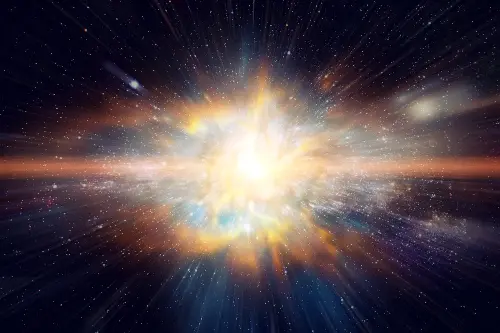Peering back into the abyss of time, the birth of the universe remains a subject that enthrals scientists and laypeople alike. The origin of all that we know starts with a singular event of incomprehensible power: the Big Bang. This quick guide will take you through the essential elements of the Big Bang Theory in a palatable manner, revealing how this complex event sparked the universe's birth.

The Singularity Concept
At the very core of the Big Bang concept lies a straightforward yet profound idea: approximately 13.8 billion years ago, the universe began as an infinitely dense and hot point called a singularity. The theory does not delve into what came before this or what prompted the event; indeed, such questions often lead to the borders of scientific knowledge and into the realms of philosophy and theology.
Expansion and Differentiation of Forces
From this initial singularity, the universe expanded at an incomprehensible rate. This was not an explosion in space—space itself was expanding, carrying matter with it. Within the first fraction of a second, the fundamental forces of the universe began to differentiate: gravity, electromagnetism, and the strong and weak nuclear forces that moulded the freshly- born cosmos.
Cooling and Formation of Matter
It's essential to understand that the Big Bang was not an event that happened at a particular location in space; rather, it happened everywhere, simultaneously. As the universe expanded, it cooled, leading to the formation of subatomic particles and later simple atoms. The cooling phase allowed the universe to transition from a hot, dense state to the current form we observe today. It's akin to steam from a kettle cooling down to form water droplets, but on an unfathomably vast cosmic scale.
Evidence from Cosmic Microwave Background Radiation
One of the earliest and most important pieces of evidence supporting the Big Bang theory came in the form of cosmic microwave background radiation (CMBR). Discovered by accident in 1965, the CMBR is the afterglow of the Big Bang itself, a faint cosmic hum that permeates the entire universe. Importantly, this radiation is uniform in all directions, providing a snapshot of the early universe and supporting the hypothesis of the Big Bang.
Elemental Distribution
The distribution of elements supports the Big Bang theory as well. Predictions state the conditions of the early universe should have created certain elements in specific ratios. Hydrogen and helium, the two lightest elements, are found in abundance and match those early universe predictions. This lends credence to the theory as it indicates that these elements were created as a result of the cooling of the universe as it became less dense.
Galactic Movement and Hubble's Law
Another compelling evidence for the Big Bang comes in the form of galactic movement. Edwin Hubble, in the 1920s, observed that galaxies are moving away from us, and the further away a galaxy is, the faster it appears to be receding. This is known as Hubble's Law and is interpreted as a direct consequence of the expansion of the universe. If the universe is expanding, it must have been smaller in the past; trace this back far enough, and you arrive at the singular point of the Big Bang.
Formation of Stars and Galaxies
The evolution of stars and galaxies further enriches our Big Bang tapestry. As the universe expanded and cooled, regions of slightly higher density began to form due to the gravitational attraction. Over billions of years, these denser areas became the stars and galaxies we see today. The large-scale structure of the universe, from galaxies to the vast voids between, is believed to have grown from these initial density variations.
Challenges and Mysteries
Despite its widespread acceptance, the Big Bang Theory is not without unanswered questions. The concept of dark matter, an unknown and invisible form of matter thought to make up approximately 85% of the universe's total mass, arises from the gaps in our understanding. Additionally, the theory grapples with the idea of dark energy, a mysterious force accelerating the expansion of the universe.
As we gaze into the night sky, we are actually looking back in time; light from distant stars and galaxies takes time to reach us. In understanding the Big Bang, we must embrace a dynamic picture of the universe, where the very history of over 13 billion years is written in the light we see today. It is an unfolding story that begins with a singularity and expands into the cosmos we know—a narrative filled with mysteries yet to unravel.
The beauty of the Big Bang Theory lies in its simplicity as a starting point for our understanding, combined with the profound complexity of its implications. It stands as a testimony to human curiosity and our relentless pursuit of knowledge. Our understanding may evolve with new discoveries, but the quest remains the same: to comprehend the origins of our universe and, ultimately, our place within it. The quest for cosmic knowledge continues, balancing on the edge between what is known and the unfathomable mysteries that lie beyond.
